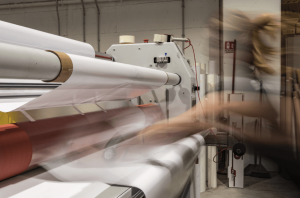Many people use laminating services these days because they provide so many obvious benefits. For example, they can protect delicate substrates, offer a more decorative finish, and improve wear and water resistance. However, it is important to apply them correctly for the best results. We work to deliver that and have a proven record of providing excellent solutions.
Lamination gives digital print materials structural stability and protection
You may be someone that is considering laminate for digital print materials. The application can  offer them structural stability. Not mention, they gain protection against superficial damages and water. However, there is a vital thing to remember; using the wrong film can lower visual quality. You have to look at this when you decide what to do.
offer them structural stability. Not mention, they gain protection against superficial damages and water. However, there is a vital thing to remember; using the wrong film can lower visual quality. You have to look at this when you decide what to do.
Laminating services are wise for any materials that will be in an environment where they could get brushed against or wet. Also, it is mandatory to consider UV protection with inkjet print. This is because the sun can swiftly fade pigments in thin solvent inks and aqueous ones. UV isn’t as much of a problem with thermal resin and eco-solvent prints. Abrasion challenges still exist though, with lamination delivering strong protection.
Prints using UV curable inks can produce trouble with lamination at times. They sit on top of your print media. What this does is produce an uneven exterior to apply the laminate to. It can cause silvering as well. Here, fine quantities of air become trapped between the media and film.
If you produce your prints using UV-inks, you should confirm that you can use your laminates with them. These films normally come with a thicker adhesive. It enables it to conform around the inks.
Specifying the right laminate and introducing it at the correct time is vital to achieving outstanding results. We will be going over what you need to know about these two things in this post. You can then come to us for laminating services.
When is the right time?
Firstly, we will go over when to laminate digital prints. It is essential for you to let inks dry/cure completely prior to lamination. Vapours within solvent inks off-gas for hours following printing. Moisture inside aqueous inks evaporates too. Everything needs to go somewhere.
Should you laminate over media too early, off-gassing can’t happen. The film is not going to stick correctly thanks to trapped air. Some solvent printers come with instant curing stages. They accelerate off-gassing. Generally though, it is recommended that you laminate 24 hours after printing for commercial media. If you use minimal ink, then a 6-12 hour window can work.
You can speed up drying and curing using a heat treatment. But, it is typically easier and more economical to allow the ink to cure naturally on huge print runs.
Prints on UV-C and Latex machines don’t need outgassing. You are able to laminate them straight away. At the same time, it is still a good idea to leave everything to settle for an hour at least. This will give you the best results.
Laminating large format prints
Next, we will discuss why you should laminate large format prints. It protects digital print against several things. This includes UV light, abrasion, and moisture. Media in danger of suffering damage is at least ten times more durable if you choose laminating services. It will last longer and save you money for future jobs.
To give an example, UV-resistant laminate film has the potential to prolong the life of outdoor media that is printed with aqueous ink. It can extend it from six months to roughly four years.
The majority of professional printers supply lamination as standard with commercial media and signs. They do so as it is considered a minimum requirement. If the option is available to you, laminate improves durability. Yet, you may not need it if the media will reside behind a display such as an A-frame.
Wide format printing
Lastly, we want to discuss the kinds of laminates you can use for wide format printing. You should laminate any digital print materials in need of durability.
Laminates come in two forms. There are clearcoats and adhesive film. You apply the films cold or hot depending on the project. A hot press is appropriate for aqueous inks. Cold ones employ pressure and are appropriate for eco-solvent inks.
With clearcoats, they are for textured media where films won’t stick to the exterior with lasting results. You have the option of water and solvent-based ones. To ensure compatibility, pick the opposite. For example, choose a water-based clearcoat for solvent ink. Unlike laminate films which you press into position, you spray, roll, or brush clearcoats onto media. You do so using a liquid laminator.
Work with our expert team for first rate laminating services
At Foiling Services, we offer our clients’ items a fantastic level of protection with our lamination work. The new appearance will also be attractive and distinguished. By working with our world class team, you will receive all the benefits that come with our years of expertise.
So, please contact us if you wish to discuss your specifications for laminating services. We can cater for a huge array of needs.
